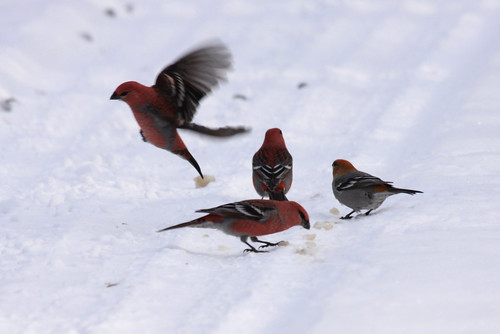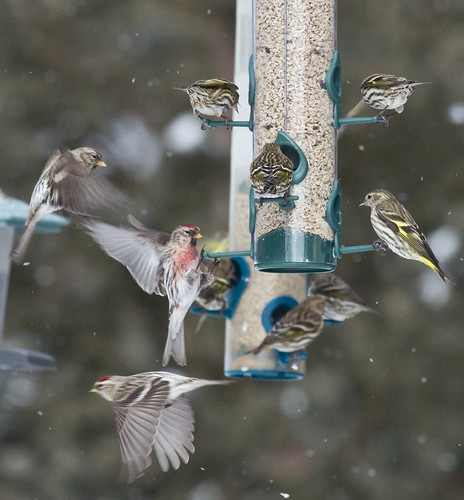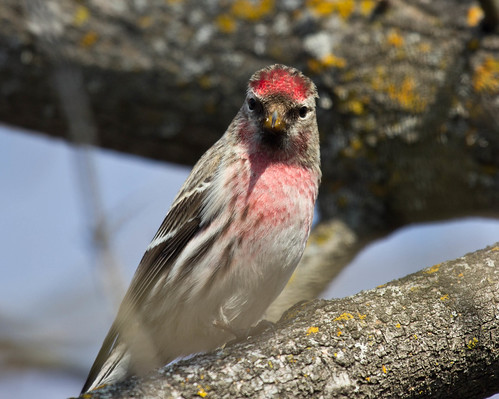 |
| Pine Siskin |
2015 is one of the magical years when lots of us are seeing gregarious winter finches that spend most of their lives in the northern reaches of Canada, Eurasia, Iceland, and Greenland, such as redpolls, or at least in the boreal forest of Canada and the northern reaches of the US, such as Pine Siskins. People notice them by their frequent, almost continual calling as they seem to be invisible within dense conifers, by how they congregate at feeders, and by how they gather at the salt and grit on country roads, barely taking off in time as we drive through. Finches feed almost entirely on seeds, and the grit they eat both helps their gizzard grind down seeds so they can extract as much food value as possible, and provides minerals that their simple diet lacks. Winter road salt lures them in even more than bird feeders do.
 |
| Pine Grosbeaks on road. |
It seems to me a no brainer that when flocks of birds are on the road, people should slow down, not just because of the immediate danger to the flock right there but because there are so many flocks all along. But our mindset gets so locked into human concerns, even as we drive through the most hauntingly beautiful northern forest habitat, that most people don’t even notice the enormous Great Gray Owl or the exquisite Northern Hawk Owl perched atop a tree right in the open near the road, much less the hundreds of little brown birds that look like leaf litter until they flutter off as we get too close. I see so many of them dead on the roads, and sometimes stuck onto car grilles—including those of birders who were in such a hurry to see the next new bird that they plowed right through the ones right there.
 |
| Pine Siskins and Common Redpolls |
When we see these finches in their big flocks, it’s easier to see them as aggregations rather than individuals. Of course, birders carefully scrutinize each individual in hopes of picking out a possible Hoary Redpoll among the Common Redpolls, or to find other outliers, but once our list needs are served, we all at least occasionally look at these flocks as undifferentiated winter finches rather than breaking them down into individual species. And even when we do that, we seldom pay the kind of attention to individuals that we do when we encounter an owl or shrike or curious chickadee.
The more scientists reveal about bird intelligence and individual variation, the more strenuously people seem to grab onto that popular meme that individual animals don’t matter—only populations.
I’ve always found that a depressing concept, because it’s so egotistical. In terms of wildlife management and conservation, of course the focus must be on populations, but within these two disciplines, our sense of the appropriate size of populations is informed not by what is best for the larger world but by what will serve a given human “user group.” Red-winged Blackbirds are slaughtered by the millions in western Minnesota and the Dakotas every spring to appease sunflower growers. Cormorants are slaughtered in many areas to appease sport and commercial fishing interests. Meanwhile, white-tailed deer and Canada Goose numbers have been “managed” to bring them to unsustainable levels over decades, to please hunting interests, even after it was obvious that their numbers were growing too large for the health of major habitats and competing species. Now we’re watching that exact same ecological disaster slowly unfold with Wild Turkeys. Meanwhile, I hear the same delight in shortsighted people seeing turkeys in their area for the first time that I heard back in the 70s when people were so thrilled to see Canada Geese raising young in places they’d never before bred.
We are supposed to be the smartest species on the planet. We could use our intelligence to look at the Big Picture of population levels even as we see the Little Picture—the value of individuals of all species. We could learn from our mistakes. We could use our supposedly superior awareness to notice the beauty all around us. And we could use our supposedly superior ability to plan ahead so we’d leave early enough to drive a little slower during times when birds gather on our roadsides. Forest Gump famously said “stupid is as stupid does.” The same also could be said of human intelligence.
 |
| Common Redpoll |



